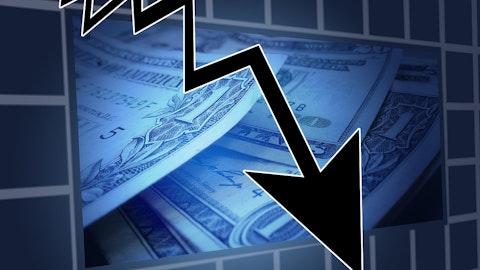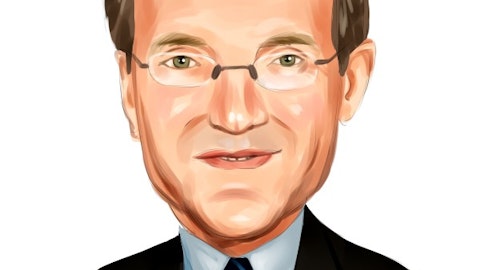And on the topic of expenses, I’ll just add that I think that really is a journey, not a destination. We always have to be looking at expenses. I don’t think this will be the end of taking a really hard look at what we can do over time. And I think of expense reduction as really having a purpose for twofold. One is to create capacity for investment, which continues to be critically important, probably more so now than ever. And then secondly, to make sure we get that positive operating leverage. So, we will continue to kind of keep an eye on not just normal budget hygiene, but actually seeing what more significant steps we can take over time. So, as I said, a journey, not a destination. And I think ’25 should have things moving in the better direction, but again, not a complete line of sight into that.
John Pancari: Okay. Great. Thanks, Jim.
Jim Herzog: Thank you.
Operator: Thank you. [Operator Instructions] Our next question is coming from Jon Arfstrom from RBC Capital Markets. Your line is now live.
Jon Arfstrom: Hey, thanks to each and everyone.
Curt Farmer: Good morning, Jon.
Jon Arfstrom: Hey, good morning. Question on your net interest income guide. What kind of rate assumptions do you have in that? And any kind of rate scenario that you think derails that from what you’re thinking today?
Jim Herzog: Yeah. Good morning, Jon. Yeah, we did assume the 12/31 forward curve, which has almost six rate cuts in it. You’ll notice on our asset sensitivity page that for the first time that I can recall, at least, we became liability-sensitive. So, I think this is a very fortuitous time for us to become liability-sensitive with potentially six rate cuts out into the future. We do have the sensitivities there using a 60% beta. You can see that we do benefit from falling rates assuming that we can reprice as expected without too much of a leg. So, I would say if we get fewer cuts than that, that will put a little pressure on that outlook. But we are benefiting from the 12/31 curve if we really do get those six cuts. So, that’s the assumption. And we’ll continue to monitor and we’ll see where the economy and where the FOMC goes.
Jon Arfstrom: Okay. Yeah. A lot going on this morning. I had to rub my eyes when I saw that slide. I guess, my — one of my follow-up questions, and maybe you answered it, is, do you still consider yourself asset-sensitive? And I guess the answer is, no, at this point.
Jim Herzog: That’s what our models would say. You never know how customers are going to react and the competition is going to react. But I would say we are a little more liability-sensitive than we are asset-sensitive. Now, that liability-sensitive could have a little bit more of a leg in it than what we’re projecting. We just don’t know how customers and competition will react. But over the course of time, it does appear that we are a little more liability-sensitive.
Jon Arfstrom: Okay. Point of clarification on the expense piece of it. Is it $45 million in ’24 and an incremental $55 million in ’25, or an incremental $10 million in 2025?
Jim Herzog: Incremental $10 million.
Jon Arfstrom: Okay. Good. And then, one, Melinda, I thought you’d get a pass, but I wanted to ask one credit question.
Melinda Chausse: Sure.
Jon Arfstrom: On Slide 13, that bottom right corner where you show the percent criticized in TLS, leveraged and auto, curious how elevated is that relative to normal. I don’t know if there is a normal, but how elevated is that? And what does it take for those to come back down?
Melinda Chausse: Yeah. Thanks for the question. I mean, surprise — not surprisingly, but a positive surprise this quarter was that we actually saw improvement in three of the four incremental monitoring portfolios. So, we saw balances and criticized assets go down in TLS, leveraged and automotive production. I would say that, that leveraged portfolio at 10% to 12% is about normal. That is an elevated, higher risk portfolio by its very design. TLS, again, is going to be elevated above the normal portfolio at 18%. I would say that’s still above sort of historical norm. But we are seeing positive momentum in TLS. Certainly, the rate environment, if it cooperates with the forward curve, is going to be a real positive for that segment as well as leverage.
You didn’t ask about commercial real estate specifically, but we did see that one relatively flat in the fourth quarter. So, we’ve got some assets that are moving into the criticized bucket, but we also have assets that are moving out of the criticized bucket. And they move out when they either pay off or we re-margin them and get them back into a conforming state. So, I feel really good about all of those portfolios that are listed there on the right, and would expect that we should — again, if the rate environment cooperates and we don’t see a downturn in the economy, that we’ll continue to see these stable to potentially improving towards the back half of the year.
Jon Arfstrom: Okay. Good. That’s very helpful. Thank you, Melinda.
Melinda Chausse: You’re welcome.
Curt Farmer: Thanks, Jon.
Operator: Thank you. Your next question today is coming from Steven Alexopoulos from JPMorgan. Your line is now live.
Curt Farmer: Good morning, Steve.
Steven Alexopoulos: Good morning. So, I want to start by going back to your answer to Peter’s question, the first question on NIM. And it’s funny, for all the years I’ve covered the company, I think you were the most asset-sensitive. And if you look at the historical NIM range, it’s literally all over the place. And, Jim, what you’ve done now is you’ve basically restructured the balance sheet, so it’s fairly neutral. Even if I look at this 100 basis point gradual, it’s 60% beta, it’s like 6 bp or so benefit to NIM. So, assuming that we get here, let’s say, the forward curve plays out, we go to 100 basis points or so of steepness, does that imply your NIM, the new NIM for Comerica is like 3%, right? Historically, I mean, a year ago, you were 3.74%, come down a ton.





